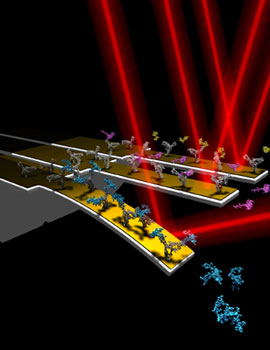|
HOME | SEARCH | ARCHIVE |
|
Microchip has potential to diagnose prostate cancer and other diseases, researchers say
![]()
By Robert Sanders, Public Affairs
| |  Three cantilevers coated with antibodies to PSA, a prostate cancer marker found in the blood, bend as the protein binds to the antibody. |
06 September 2001
|
A clever technique for detecting proteins by inducing them to stick to and bend a microscopic cantilever — essentially a diving board the size of a hair — could serve to detect protein markers indicating prostate cancer, a team of scientists reported last week in the journal Nature Biotechnology. These protein markers — called PSA for prostate-specific antigen — are found at elevated levels in the blood of those with prostate cancer, which is the number two killer of men in this country. “The technique is sensitive enough to detect levels 20 times lower than the clinically relevant threshold,” said lead author Arun Majumdar, professor of mechanical engineering. “This is currently as good as and potentially better than the ELISA assay, which is the standard today for detecting protein markers like PSA.” The microcantilever technique has far broader applications as well. Any disease, ranging from breast cancer to AIDS, characterized by protein or DNA markers in blood or urine could conceivably be assayed by arrays of these microcantilevers. A microcantilever array would be one of the first “protein chips,” analogous to the DNA chip used today in research labs and the biotechnology industry to conduct hundreds of DNA analyses simultaneously. “This could lead to fast screening and molecular profiling for many diseases and a possible cancer chip for detecting cancer,” said Majumdar, a member of the Health Sciences Initiative. With the new technology it is possible to look at multiple markers in a single reaction, making it potentially much cheaper to perform than a typical ELISA assay. Another advantage this technique has over current assays such as ELISA — enzyme-linked immunosorbent assay — is that there is no need to attach fluorescent tags to molecules. This could prove very useful in testing how well candidate drugs bind to their targets, since drugs typically are so small that attaching fluorescent labels interferes with their binding to a protein or enzyme. The technique is ideal for detecting single base-pair variations in DNA, the most common form of biological diversity, notes coauthor Richard Cote, professor of pathology and urology at the Keck School of Medicine of the University of Southern California and the USC/Norris Comprehensive Cancer Center. Thanks to the human genome project, scientists are finding more and more of these single nucleotide variations — called single nucleotide polymorphisms, or SNPs — and expect them to have major significance in biomedical research. "From a discovery point of view, this is a very, very important advance," Cote said. Majumdar and his coauthors, including Berkeley graduate student Guanghua Wu, report their findings in the Sept. 1 issue of Nature Biotechnology. Wu fabricated the cantilevers from silicon nitride using techniques identical to those employed by the semiconductor industry to make microprocessors. He worked closely with Oak Ridge colleagues, who perfected a way to coat the top surfaces of the cantilevers with antibodies. When proteins bind to these antibodies, they elbow one another apart and force the lever to bend downward. Lasers can detect a deflection as small as a fraction of a nanometer, however. That is the equivalent of a cantilever the length of a football field bending the mere width of a quarter, said coauthor Thomas Thundat of Oak Ridge National Laboratory in Tennessee. "The primary advantage of the microcantilever method originates from its sensitivity, based on the ability to detect cantilever motion with sub-nanometer precision, as well as the ease with which it may be fabricated into a multi-element sensor array," he a nanometer. "No other sensor technology offers such versatility,” said Thomas Thundat of Oak Ridge National Laboratory. Majumdar and his Berkeley colleagues have found a way to put several hundred cantilevers onto a single silicon chip, and have developed a way to measure the deflection of all simultaneously with a single low-power laser or light emitting diode,” he said. “In just two years, this has gone from a possible way of detecting biological reactions to a highly sensitive method for detecting PSA, comparable to the best assays currently available,” said Cole. “In a very short period of time, we’ve really made enormous advances. I’d be surprised if this doesn’t become a viable assay system within the next three to five years.”
Home | Search | Archive | About | Contact | More News
Copyright 2000, The Regents of the University of California.
Produced and maintained by the Office of Public Affairs at UC Berkeley.
Comments? E-mail berkeleyan@pa.urel.berkeley.edu.